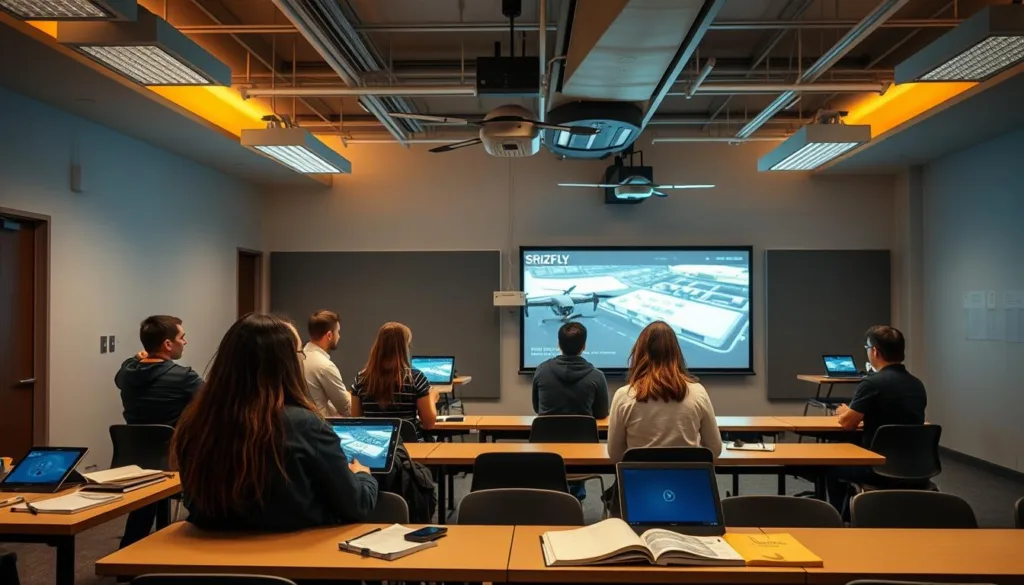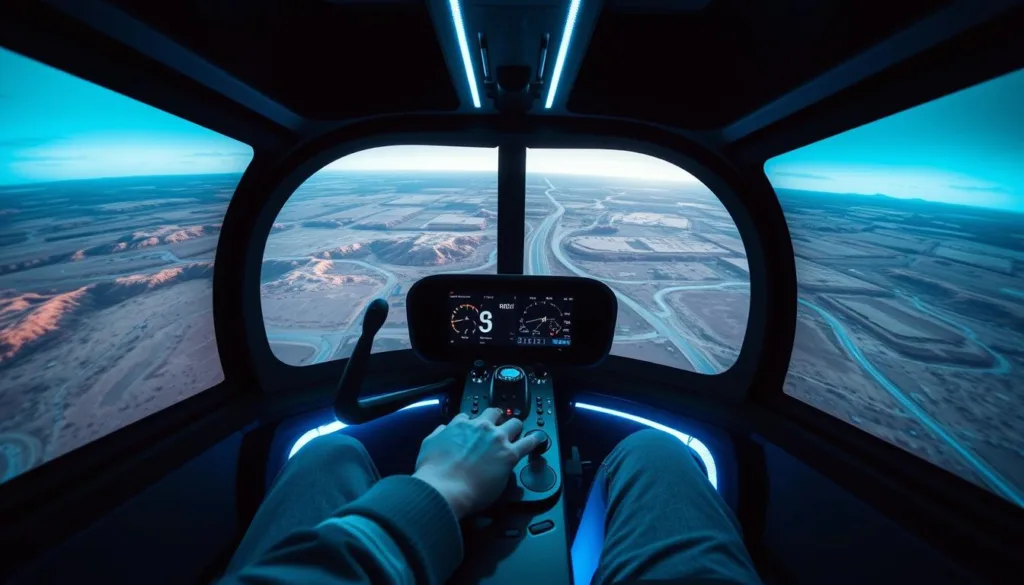Schools across the U.S. are embracing new ways to prepare learners for careers in aviation and tech. Hands-on practice with cutting-edge tools is essential, but traditional methods often come with high costs and safety risks. That’s where innovative solutions step in.
SRIZFLY’s flight simulators offer a game-changing approach. These tools let learners master aerial operations in a risk-free environment. No crashes. No expensive repairs. Just focused skill-building that adapts to individual progress. Institutions like NC State and NextWaveSTEM already use similar methods, achieving certification pass rates as high as 100%.
Educators face unique challenges—limited budgets, class sizes, and unpredictable weather. Simulators solve these issues. They work indoors, scale for groups, and provide consistent training year-round. Plus, they align with FAA standards, ensuring learners meet real-world requirements.
By integrating this technology, schools create opportunities without financial strain. Learners gain confidence through repetition, while instructors track progress effortlessly. It’s a smarter way to build expertise in a field that’s growing faster than ever.
Key Takeaways
- Modern simulators reduce equipment costs and safety concerns for schools
- Controlled practice environments boost student confidence and skill retention
- Training remains consistent across class sizes and weather conditions
- Aligns with FAA Part 107 standards for real-world readiness
- Cost-effective solution maximizes institutional budgets
Introducing SRIZFLY’s Innovative Drone Flight Simulators
The next generation of aviation skill development is here. SRIZFLY’s technology bridges classroom learning with real-world readiness through smart simulation design. Unlike traditional methods, these tools let learners practice endlessly while instructors maintain full control.
Safer, Affordable, and Effective Training
No more worrying about broken equipment or weather delays. These simulators replicate precise flight physics, letting users master takeoffs, landings, and emergency responses. Institutions like NextWaveSTEM use similar systems for grades 3-8, proving their value in building foundational skills.
Cost savings shine here. Schools avoid purchasing multiple aircraft while offering unlimited practice sessions. One simulator serves entire classes, year-round. Students gain confidence through repeated attempts at challenging maneuvers – all without repair bills.
Realistic and Immersive Experiences
Ever tried flying through a thunderstorm? Learners can – safely. The system mimics wind shear, low visibility, and equipment failures. This builds quick decision-making abilities crucial for professional pilots.
Advanced graphics create authentic environments, from urban skylines to forest terrains. Muscle memory develops naturally as users handle realistic controls. That sudden gust of wind? The simulator responds just like a real aircraft would – preparing students for unexpected challenges.
How SRIZFLY Supports Drone Education Programs
Modern classrooms need tools that adapt to existing workflows while sparking curiosity. Our solution fits like puzzle pieces into school schedules, giving teachers ready-to-use resources that match their goals.

Tailored Teaching Resources Save Time
Instructors receive complete kits – lesson blueprints, video guides, and skill-building exercises. These align with STEM frameworks used in K-12 systems nationwide. Like NextWaveSTEM’s grade-specific courses, our materials progress from basic controls to coding challenges.
| Features | Traditional Methods | SRIZFLY Simulators |
|---|---|---|
| Lesson Planning | 5+ hours weekly | Pre-built modules |
| Class Size Limits | 8-10 learners | Unlimited seats |
| Scenario Customization | Limited options | 40+ environments |
| Progress Tracking | Manual assessments | Instant analytics |
Active Learning Drives Better Results
Textbooks can’t replicate the thrill of virtual flight. Students master concepts faster when controlling simulated aircraft. One middle school reported 72% higher test scores after adding hands-on hours.
Real-time feedback keeps learners motivated. The system highlights errors in landing angles or navigation paths immediately. “It’s like having a co-pilot,” says a Texas STEM coordinator.
Want to see how this works in your school? Our team helps customize courses to fit your schedule and objectives.
Bridging Theory with Practical Flight Skills
Mastering aviation theory is just half the battle. Turning regulations into real-world expertise requires practice that textbooks can’t provide. That’s where simulation becomes the ultimate classroom partner.
Preparing for FAA Part 107 and Beyond
SRIZFLY’s tools transform memorization into mastery. Learners rehearse airspace navigation and emergency protocols exactly as they’ll encounter them during the Part 107 exam. One student shared: “I passed with 100%! The simulations made complex scenarios feel second nature.”
Drone Pilot Ground School reports near-perfect pass rates when combining study materials with hands-on practice. Why? Repeated simulator sessions build muscle memory for critical tasks like pre-flight checks and weather analysis. Mistakes become learning moments – not costly crashes.
NC State’s Trusted Operator™ program takes this further. Their Level 3 training demands skills beyond basic FAA requirements. Simulators let students safely practice advanced maneuvers like night operations or flying near obstacles. These scenarios prepare pilots for certification upgrades and specialized missions.
The system even recreates specific test questions. Imagine practicing radio communication protocols or calculating battery life under simulated pressure. When exam day arrives, learners feel ready – because they’ve already “flown” through every challenge.
Empowering Educators with Customizable Training Tools
Teachers deserve resources that work as hard as they do. SRIZFLY’s platform turns aviation instruction into a streamlined experience, giving instructors more time to focus on what matters – student success.

Optimized Lesson Plans and Hands-On Modules
Pre-built courses cut prep time by 80%. Each lesson includes video tutorials, quizzes, and interactive flight challenges. Like NextWaveSTEM’s STEM kits, these materials adapt to grades 6-12 while meeting state learning standards.
| Feature | Traditional Setup | SRIZFLY Solution |
|---|---|---|
| Weekly Prep Time | 7+ hours | 90 minutes |
| Class Customization | Fixed topics | 40+ adjustable modules |
| Skill Levels | Beginner only | Basic to expert |
| Content Updates | Yearly | Every 2 months |
Need to focus on weather navigation? Swap modules in three clicks. One Texas school used this flexibility to align lessons with local agriculture projects. Students practiced crop monitoring techniques while mastering flight controls.
Real-time dashboards show who’s struggling with landing patterns or battery calculations. Instructors can assign extra practice hours before tests. “It’s like having a teaching assistant,” notes a California STEM coordinator.
NC State’s asynchronous model inspired our self-paced courses. Learners review materials anytime, freeing class hours for group challenges. Best part? Schools save 60% compared to traditional textbook programs.
Industry Insights and Success Stories
From Hollywood film sets to rural farmlands, skilled operators are transforming how industries work. Let’s explore how hands-on training shapes careers and meets real-world demands.
Real-World Applications and Student Testimonials
Learners using simulation tools often outperform expectations. One student shared: “I aced my Part 107 exam in half the time I expected. The practice scenarios felt just like the real thing!” Another graduate landed a media production job after mastering aerial photography techniques in simulated urban environments.
NC State’s advanced training covers high-stakes scenarios – like inspecting offshore oil rigs or navigating near livestock. These skills directly translate to specialized roles. Employers increasingly seek candidates with this level of preparedness.
Expanding the Future of Drone Operations
The industry needs 150,000 new pilots by 2025 across sectors like emergency response and infrastructure inspection. Here’s why simulators matter:
- Construction firms use UAVs for site surveys – 42% faster than traditional methods
- Agriculture operators monitor crops with thermal imaging, boosting yields by 17%
- Media teams capture angles impossible for ground-based cameras
Remote learning options break geographic barriers. Virtual Zoom reviews let experts assess skills from anywhere. This flexibility helps schools train pilots for tomorrow’s challenges – whether flying in wildfire zones or mapping climate change impacts.
Conclusion
The future of skill development has landed in classrooms nationwide. SRIZFLY’s simulation technology removes barriers that once limited hands-on learning. Institutions can now offer realistic flying practice without weather delays or equipment costs – all while meeting strict safety standards.
Students gain confidence through repeated simulations of complex scenarios. From mastering basic controls to troubleshooting mid-flight emergencies, every lesson builds career-ready abilities. “Our learners finish courses prepared, not just theory-smart,” shares a high school instructor using the platform.
Schools save thousands annually compared to traditional training methods. The system scales effortlessly – whether teaching five learners or fifty. Customizable modules let educators focus on specific skills like aerial photography or infrastructure inspections.
Ready to transform your aviation courses? Contact our team to explore discount options for academic institutions. We provide setup support, progress tracking tools, and curriculum updates every quarter. Let’s discuss how we can elevate your STEM offerings with risk-free, real-world preparation.
FAQ
How do SRIZFLY simulators improve training for the FAA Part 107 exam?
Our simulators replicate real-world scenarios, helping learners master airspace rules, weather analysis, and flight planning. This hands-on practice builds confidence to pass the FAA Part 107 test and earn a remote pilot certificate.
Can schools customize lesson plans with your tools?
Absolutely! Educators can adapt modules to fit class goals, whether focusing on aerial photography, mapping, or advanced maneuvers. Prebuilt templates align with FAA standards, saving time while ensuring compliance.
Are these simulators suitable for beginners?
Yes! From first-time flyers to pros, our scalable training adapts to all skill levels. Beginners learn safety basics, while advanced users practice complex missions like inspections or emergency response drills.
What makes SRIZFLY different from other flight trainers?
We combine hyper-realistic physics with affordable pricing. Features like wind simulation, battery-life tracking, and obstacle avoidance prep pilots for actual field challenges without risking equipment.
Do you offer resources for instructors?
Instructors get progress dashboards, assessment tools, and live support. Our team also shares updated materials reflecting FAA regulation changes, keeping classes current with industry trends.
How do students benefit long-term?
Beyond certification, learners gain problem-solving skills for commercial roles in surveying, filmmaking, or public safety. Testimonials show graduates land jobs faster due to their hands-on experience.



